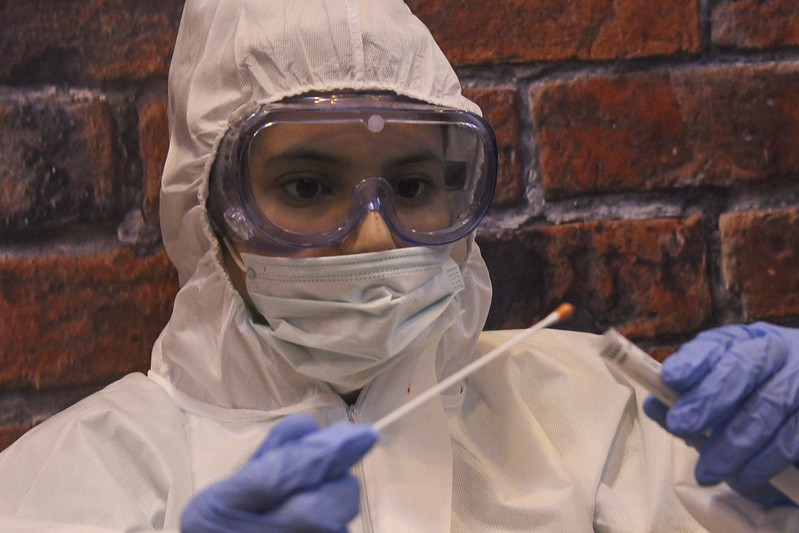Crime can be serious, grievous, and heinous but crime can also be fascinating. Listening to criminal investigations has been a source of entertainment for almost all generations: the older generation’s fixation on Indian Crime Petrol or the younger generation’s obsession with series like Mindhunter in the context of urban Nepal.
The enigmatic nature of the crime is engrossing. Almost all crime stories have sleuths, the detectives. In modern crime stories, there are new Sherlocks: the forensic experts. The experts ‘breaking the case’ with their scientific instruments—saving the day with science.
However, beyond the set of televised drama, there are real incidents, real cases, and real victims. Then a question arises: Is forensic science really triumphant in real cases like in fictional cases?
The answer is no. Forensic science is not as triumphant in reality. While those watching the televised trial of the notorious serial killer Ted Bundy might disagree, wasn’t Bundy’s indictment totally because of bite-mark evidence of forensic science that indicted an infamous villain?
While forensics might have some successes, it has its fair share of victims. One such example is the famous case of the Commonwealth of Virginia vs Keith Allen Harward. Harward was proven to be the murderer and a rapist because the bite mark left on the victim’s thighs was identical to his teeth structure.
The expert asserted that they were more than 99 per cent sure that Harward was the murderer. But, he was not. The problem with new trends in forensic science is that it is not really a science. There are no laboratory experiments, no clinical research and no tested hypothesis. It is no science. It is mere junk science!
Science vs junk science

Harward was not the only victim. In America, the Innocence Project was launched trying to identify and rescue more people who shared the fate of Harward. It identified many but could not save much as many were already given the death penalty. Those who were saved could not bear the plight of jail time, succumbing to alcoholism and mental breakdown.
Hence, the United States Government developed the Frye test, which mandated that science should be generally accepted in the relevant scientific community to be counted as evidence.
Philosophically, Cicero coined the term “ipse dexit,” which translates to ‘if I say so.’ Forensic evidence with no rigorous scientific methodology is no science. There is a difference between evidence-based information and eminence-based knowledge. Forensic science is eminence-based knowledge more than evidence-based information. Hence, it can be called junk science.
To further stunt such eminence-based knowledge, a famed tort-reform case of Daubert vs Merell Dow Pharmaceuticals Inc developed a five-part test to apply before ‘scientific’ evidence. It can be admitted in the court: 1) should have a hypothesis that can be tested 2) should have peer-reviewed scrutiny 3) there must be an error rate 4) practitioners must abide by controlling standards 5) acceptance in the scientific community but no control.
This further curbed the eminence of junk science. The truth of the matter is that forensic techniques like hair and fibre microscopy, ballistics, shoe print, tyre treads, arson investigation, blood splatter evidence, and handwriting are not objective science but rather a subjective opinion gained by experience. If the court cannot make a distinction between the two, the court falls into the trap of junk science.
From Nepal’s perspective
In Nepal, forensics is not a laissez-faire industry. According to Nepali law, forensic work should be done in a government hospital or by any expert authorised and recommended by the government.
For the most part, the police investigation’s forensic work is purely done through the governmental mechanism. However, when the case comes to court, according to Evidence Act, 1977, section 23, the government can take an expert’s opinion as evidence.
The act does not establish who should be counted as an ‘expert’ besides explaining someone with specialist scholarship, training, and experience in the field. This posits a problem what if this subjective experience sharing is mistaken as objective fact? Anyone can have a scholarship, training, and experience. Moreover, without a proper benchmark or governing body to decide who should be considered an expert is very impressionistic.
Some precedence has implicitly foretold that expert opinion is not a deciding factor in a case. The decision in the Pramila Magar vs Mohan Ghale case has elaborated that opinion on death by hanging can not be taken as the sole evidence or the primary evidence to proclaim someone suicided.
Similarly, the verdict in another case of Dhana Bahadur Rai vs Nepal Government elaborated that a DNA test attesting that the child is not of the accuser does not make it that rape did not occur. These precedence outline that these expert opinions cannot be taken as sole primary evidence.
But, what opinion can be taken as evidence is still an ambiguous business.
Forensics in Nepal is moving in the direction of objectivity and science. However, this escalation in the scientific investigation will have a junk science threat accompanying it. Nepal’s evidence law is 48 years old. The recent wave of evidence law is purely neglected. The law cannot keep up with the new trends and novel waves of forensic science. The legal ambiguities might mislead the judges into taking subjective opinion as objective fact.
Not all judges understand the science of forensics, but judges do understand statutes and precedence. If proper elaboration and jurisprudence are developed regarding forensic evidence, junk science will be defeated. Nepali legislatures need to review and reform the Evidence Act. If it is not done, the existing ambiguities and vagueness will ruin the already frail criminal justice system of Nepal.

















